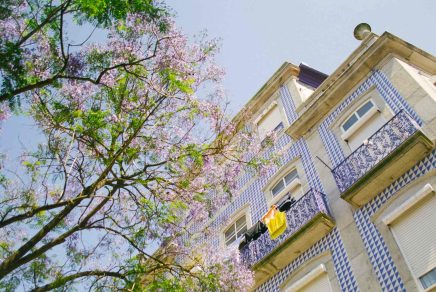Share the article
Table of Contents
Most visitors to Lisbon go, above all, to enjoy the splendour of the Lisbon’s past: its cathedral, its old buildings, its gastronomical heritage, its stone-paved streets or its famous blue tiles. But the Portuguese capital is not only a city full of history and ancient monuments. It’s also a trendy capital, open to the latest developments in the fields of art, architecture and design. The contrast between these two aspects of the city is sometimes astonishing. When visiting Lisbon, it would be a shame to do without one or the other of these perspectives.
Here are my favourite places in the city, ancient as well as modern.
MUDE – Museum of Arts and Fashion
Located in downtown Lisbon, the Museu do Design e da Moda is an exceptional museum: more than 2500 objects are presented, which sweep the history of fashion and design from 1935 to the most contemporary creations. This vast building, with its brutalist and denuded architecture, hosts both temporary and permanent exhibitions. There is always something going on: open workshops, conferences, performances or guided tours. Additionally, admission is free! If you are a design aficionado, you cannot, under any circumstances, skip this visit.
Santa Maria Maior Cathedral
More commonly known as Sé Catedral by residents, this cathedral is the oldest religious building in Lisbon. Its construction began in 1147, on the orders of the one who is considered the founder of Portugal, King Alfonso I, who had just taken back the city from the Moors. In order to affirm the new dominion of the Catholic religion in these territories, the king chose to build the cathedral on the site of an old mosque. The building survived several earthquakes, including the catastrophic one of 1775, which destroyed almost the entire city.
You’ll be able to admire, among other things, two magnificent Romanesque towers erected in the 12th century, an astonishing Gothic cloister or the baptistery that was used in 1195 at the baptism of St. Anthony of Padua. Despite several restorations, the medieval atmosphere of the building has been preserved. This visit will take you on a real journey through time.
The Calouste Gulbenkian Museum
The Museu Calouste Gulbenkian is named after one of the richest art collectors of the 20th century and houses the spectacular collection that he gathered for forty years until its death in 1955. It holds 5000 years of art history, from Mesopotamian antiquity to the Impressionist period, from the funerary masks of Upper Egypt to the fragile and aerial creations of the master glassmaker and jeweller René Lalique.
Walking through such an accumulation of works is a unique and fascinating experience. Located in the heart of one of the most beautiful parks in Lisbon, the building that houses this exceptional collection is considered a major example of museum architecture, thanks to its numerous openings that allow the visitor to enjoy nature and art, all in a glance.
As if to illustrate the mixture of the old and the modern in the Portuguese capital, the site of this museum also houses a modern art centre. Its architecture is controversial, and its amazing collections are at the forefront of contemporary art.
The São Jorge Castle
Once known as the “Castle of the Moors”, the Castelo de São Jorge is located on a hill overlooking the city and the estuary of the Tagus River, and thus offers an exceptional view of the surroundings. Former royal palace, with lush gardens and impressive views, it is one of the privileged witnesses of the long and rich history of Portugal. One drawback: in summer, tourists flock there, so enjoy the low season to take advantage of your visit.
The 28 Tram
Passing through the streets of Lisbon on the 28 tram is one of the most popular attractions of the city. The famous yellow street train will allow you to climb the splendid narrow and steep streets that lead from the famous Baixa (downtown) to the district of Alfama, the cradle of the fado.
Only the old Remodelado trams, built in the 1930s, are able to make this route, which undeniably adds a touch of nostalgia to the journey.
The Champalimaud Centre
You may be surprised to find here the address of a hospital and medical research centre. Be reassured right away, the reason for the presence of this site is purely architectural.
Indeed, this centre is one of the most modern buildings of all Lisbon. Its futuristic architecture, which perhaps recalls inspirations of science fiction, is unique. Minimalist and soothing, both zen and luminous, its audacity is the work of the famous Indian architect Charles Correa, who defines the work he has done here as “a vision of architecture in terms of beauty and a vision of beauty in terms of healing”.
The centre contains many public areas, including a terrace with a magnificent view, a cafeteria, a park and an amphitheatre facing the sea.
The Museu do Oriente
We know, of course, that Portugal has long been a colonial empire.
The Museum of the Orient, nestled in a magnificent industrial building of immaculate white, opened its doors in 2008 to present to the public an outstanding collection of art and objects related to the Portuguese presence in Asia, in particular in the former colonies of Macau and Timor.
You can admire both Indonesian painted silk pieces and Japanese screens, Ming vases of a remarkable rarity or the beautiful Kwok-On collection, dedicated to the performing arts in Asia.
The MAAT
The Museum of Arts, Architecture and Technology in Lisbon is one of the latest museums to have opened its doors in the capital.
Its distinctive architecture alone is worth the visit. The museum is located on the site of a former power station built at the beginning of the 20th century. Its architecture, designed by Britain’s Amanda Levete, aims to reconcile the city and the water. One can thus see the sea reflecting on the ground of the museum, or contemplate the light of the sun, which passes the doors of the museum, imitating the movement of the waves. The museum collections and assets will delight contemporary art lovers. They merrily blend modern art, science, media and urban planning.







